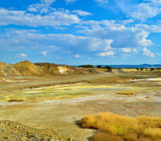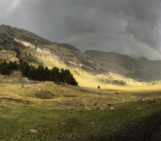
About 5,000 years ago, the ancient city Troy was founded, Stonehenge was under construction, and in the rugged Sierra Nevada mountain range, groves of bristlecone pine seedlings began to take root. Many of these pines are still alive today, making them the world’s oldest known living non-clonal life forms. Raphael Knevels, a PhD student from the Friedrich-Schiller-University’s Department of Geography in Jena, Germany explains why these particular species live so long.
On a field trip in the western United States, my colleagues and I traveled to various interesting spots in the beautiful and scenic diverse California. One of the most unforgettable places we visited during our trip was the Inyo National Forest in the eastern Sierra Nevada mountain range. Here, we could experience the oldest known individual living life forms on Earth: the bristlecone pines.
Scientific interest in the bristlecone pine started around 1953 with Edmund Schulman, a dendrochronologist from the University of Arizona who studied tree-rings to better understand the impact of past climate change. Schulman and his scientific team discovered many ancient trees, some older than 4,000 years. But why do bristlecone pines persist so long?
Bristlecone pines are located in the upper-mountain ranges of the Great Basin of the western United States in altitudes of 2,700 to 3,700 m. The environment is relatively arid with an annual rainfall of around 315 mm. They grow typically on limestone outcroppings that provide sparse ground cover and scarce litter, making the trees relatively safe from wildfires. Especially at high-elevation sites, the population is isolated, stands are open and productivity is low. Scientists believe that past fires in the region have been infrequent, usually small, and of low-severity, with an expected likelihood of an outbreak occurring once in 300 years. Moreover, their retention of needles for 20 to 30 years provide a kind of stable photosynthetic capacity that can carry a tree over several years of stress. Some species have even shown drought-sensitivity records in their growth-ring sequences of almost 1700 years.
With the ongoing global warming, the effects that our changing climate will have on the bristlecone pine are assumed to be severe; increasing temperatures can lead to a higher pine mortality rate and can introduce invasive weeds and lower elevation conifers. This can in turn change the composition of organic material on the soil surface, and as a result, make the region more prone to wildfire.
Generally, the ecosystem of the bristlecone pine is still not fully understood, and the tree’s longevity remains a mystery. More research must be done to better understand the pine’s relationship with its environment and create appropriate adaption strategies to manage this species within a human-introduced changing climate. On that the trees continues to be the longest-lived life forms on Earth.
By Raphael Knevels, Friedrich-Schiller-University Jena (Germany)
Imaggeo is the EGU’s online open access geosciences image repository. All geoscientists (and others) can submit their photographs and videos to this repository and, since it is open access, these images can be used for free by scientists for their presentations or publications, by educators and the general public, and some images can even be used freely for commercial purposes. Photographers also retain full rights of use, as Imaggeo images are licensed and distributed by the EGU under a Creative Commons licence. Submit your photos at http://imaggeo.egu.eu/upload/.




